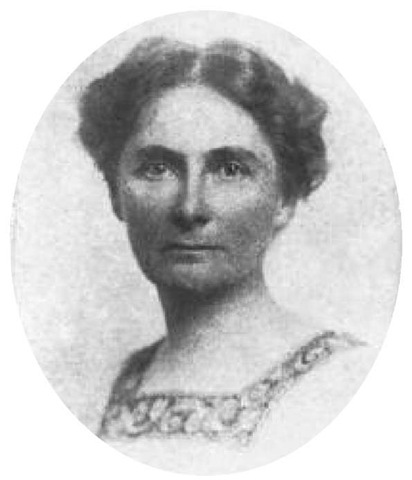(1862-1945) American Field Geologist, Petrologist
Florence Bascom is considered the “Grand Dame of American Geology.” She was truly a pioneer who enabled women to make a name for themselves in the traditionally male-dominated field of geology. Even though she was the second woman in the country to earn a Ph.D. in geology (following Mary Holmes, who earned a Ph.D. in geology from the University of Michigan in 1888), Bas-com was a first for women in geology in almost every aspect of her geological career. The U.S. Geological Survey hired her as their first woman geologist; she was the first woman to present a paper before the Geological Society of Washington; she was the first woman admitted to the Geological Society of America in 1924; and the first woman officer of Geological Society of America (vice president, 1930). She was an associate editor of the American Geologist from 1896 to 1905. In the first edition of American Men of Science published in 1906, she was regarded as a four-star geologist. This meant that her peers and colleagues regarded her as one of the top 100 geologists in the United States.
Florence Bascom became an expert in mineralogy, petrology, and crystallography. Her dissertation was her earliest and one of her most important contributions to geology. Using petro- graphic (optical microscope for rocks) methods, she showed that rocks that were previously considered sedimentary were actually metamorphosed lava flows. She continued research in this area and established herself as one of the foremost experts on crystalline rocks in the central Appalachian Piedmont. This research included mapping vast areas in Pennsylvania and Maryland but also topical studies on metamorphic processes. Her tight coordination of petrographic work with the fieldwork was considered cutting-edge methodology at the time. Her contributions to Piedmont geology are still valued and used by geologists working in that area today. Later in her career, she expanded this interest to include the development of mountain belts in general, especially with regard to crystalline rocks.
Florence Bascom was born in Williamstown, Massachusetts, on July 14, 1862, the youngest of six children. Her father, John Bascom, was a professor of oratory and rhetoric at Williams College, Massachusetts. He was a strong supporter of women’s rights and spoke publicly regarding the importance of a college education for women. In 1874, he became president of the University of Wisconsin at Madison and in 1875 the university began admitting women. Florence Bascom enrolled in the fall of 1877. Even with limited access to the library and the gym and not being allowed to enter classrooms already filled with men, she earned a bachelor of arts and letters degree in 1882 and a bachelor of science degree in 1884. She then became interested in geology and went on to earn a master of science degree in 1887 also from the University of Wisconsin. She continued her graduate studies at Johns Hopkins University in Baltimore, Maryland, but was required to sit behind a screen during classes so she did not distract the male students. She graduated with a Ph.D. in geology in 1893.
Portrait of Florence Bascom
Florence Bascom began her college teaching career as soon as she completed her undergraduate degree. She taught at the newly founded Hampton School of Negroes and American Indians (currently Hampton University) in Ohio, 1884-1885, Rockford College, Ohio, from 1887 to 1889, and Ohio State University from 1893 to 1895. After completing her Ph.D., she began her famous teaching career at Bryn Mawr College, Pennsylvania, in 1895 where she single-handedly developed the Department of Geology. In 1896, she was also hired as an assistant geologist by the U.S. Geological Survey to map the geology of Pennsylvania, Maryland, and New Jersey during the summer months. In 1909, she was promoted to geologist. Florence Bascom retired to professor emeritus from Bryn Mawr in 1928, but remained active until her death on June 18, 1945, as the result of a stroke.
Florence Bascom was an author on research publications that total nearly 40, including USGS bulletins and portfolios, as well as journal articles. Most of these papers are on the crystalline rocks of the central Appalachian Piedmont. She also published the extensive research she conducted on Piedmont geomorphology (provenance of surficial deposits). Her accomplishments must also include the training of some of the most prominent women geologists of the time. Louise Kingsley, Katherine Fowler Billings, petrologists ANNA I. JONAS STOSE and Eleanora Bliss Knopf, crystallo-grapher Mary Porter, paleontologist Julia Gardner, all of whom went on to have careers with the USGS, were among Bascom’s protegees. Also included among her students were petroleum geologist Maria Stadonichenko, Barnard’s glacial geomorphologist Ida Ogilvie, Isabel Fothergille Smith of Scripps College, Bryn Mawr’s Dorothy Wyckoff, and Anna Heitonen. Florence Bascom firmly established the first gateway at Bryn Mawr College for women to enter the field of geology. It would be many decades before any other school even approached her success.

